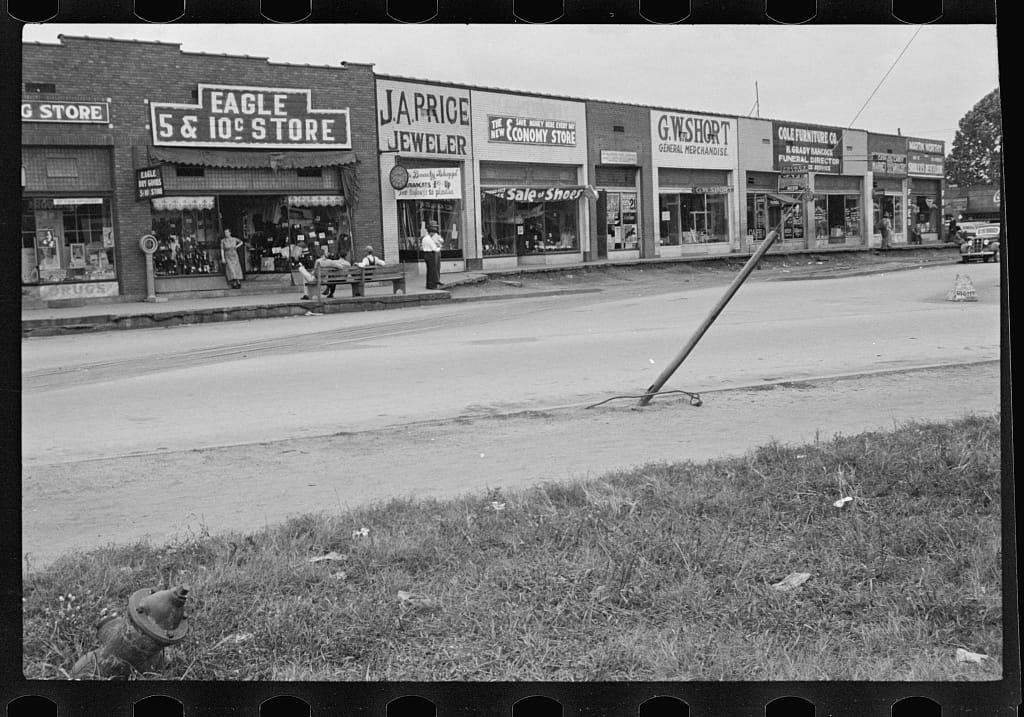

Uh oh...
It appears that you're using a severely outdated version of Safari on Windows. Many features won't work correctly, and functionality can't be guaranteed. Please try viewing this website in Edge, Mozilla, Chrome, or another modern browser. Sorry for any inconvenience this may have caused!
Read More about this safari issue.

For this month in Arkansas history, we celebrate the beginning of a large company and a small town, Atkins getting in a pickle and some Arkansas college history.
First Walmart Store Opens

The first store to bear the name Walmart opened in Rogers on July 2, 1962, at 719 W. Walnut. Sam Walton, who was born in Oklahoma, had previously owned the Ben Franklin store in Newport, as well as Walton’s 5 & 10 on the square in Bentonville, which had opened in 1950.
By 1967, the Waltons owned 25 stores in rural towns and had sales of $12.7 million. The company officially incorporated as Wal-Mart Stores, Inc., in 1969 and was publicly traded beginning in 1970 (original stock price: $16.50 a share).
The first Supercenter opened in 1980 and the first Sam’s Club in 1983. Walmart store 1 is now a Supercenter and is located at 2110 W. Walnut in Rogers.

Photo courtesy Library of Congress, Farm Security Administration photos, Main Street Marked Tree Oct. 1935.
Happy Birthday, Marked Tree
The town of Marked Tree in Poinsett County was incorporated on July 8, 1897. According to the Encyclopedia of Arkansas, it may be the only town in the world with that name.
Another unique feature of Marked Tree is that it is situated between two rivers, the St. Francis River and the Little River, which are at times as close as a quarter of a mile to each other, yet they flow in different directions.
The town was named for an oak tree that had been marked with a foot-tall M that sat on the bank of the Little River. The theory is that John Murrell’s band of outlaws marked the tree, which fell into the river during a flood in 1890.
The farmland around the town was sunken because of earthquakes on the New Madrid fault line. Levees, drainage ditches and the Marked Tree Lock and Siphons have all been used to help control the flow of water from the rivers.
During World War II, the town was the location for a German prisoner-of-war camp. Prisoners did farm work and were returned to Germany after the war.
As of the 2010 Census, Marked Tree had a population of 2,566.

St. John’s College Founded
St. John’s College in Little Rock became the first institution of higher learning chartered in the state of Arkansas – though it was the third to actually open – when land was purchased for the school on July 16, 1852.
The school was run by the Freemasons, who paid $5,500 for 100 acres of land located east of the federal arsenal (it’s now MacArthur Park). It was five years before the school raised enough funds to begin construction of buildings, and the first class of about 50 students began on Oct. 10, 1859.
When the Civil War broke out the Confederate Army was given permission to use the college as a hospital. When the Union took the city they also used it as a hospital. The execution of David O. Dodd took place there.
After the war, the land and buildings were returned to the college, and classes resumed but it lacked funding, and in 1878 the Freemasons ended their funding of the school. A professor leased the school from the Masons, but they decided to sell the property to raise funds for a new Masonic temple in Little Rock.
The property was on the market from 1882, when the school closed, until 1889, when it was sold for $25,000. The buildings at the college burned to the ground in January 1890.

Photo courtesy of produced by the Secretary of State’s office.
Atkins in a Pickle
Though they are not manufactured there any longer, pickles are what Atkins is known for, and the first test run at the Atkins Pickle Company plant happened on July 17, 1946. The factory opened a few days later and had around 100 employees.
The factory had two buildings with 57 wooden tanks that could hold 1,000 bushels of pickles each.
The company failed to make a profit in its first two years and was sold several times of the years, but by 1966 the company made $3.1 million in sales of pickles and pickled baby tomatoes, among other products.
The plant was sold to Dean Foods in 1983, but it was closed in 2002. Atkins still hosts the annual Picklefest in May, and the factory is now home to Atkins Prepared Foods.

Joseph T. Robinson when he was Senate Majority Leader, with Senator Charles L. McNary,
Republican Minority Leader, 1937. Library of Congress.
Births and Deaths
George Washington Donaghey, the 22nd governor of Arkansas, was born July 1, 1856, in Louisiana, though the family moved across the border soon after he was born. He ran away from home at the age of 15 to become a cowboy in Texas, but eventually settled in Conway.
He played a role in three colleges being established there: Hendrix College, Central College and the State Normal School (now the University of Central Arkansas). He served as governor from 1909 to 1913 and his passion for higher education and charitable work continued throughout his life.
Joseph Taylor Robinson, the 23rd governor, died July 14, 1937. He served five terms in Congress and announced his candidacy for governor in 1912 while still in Congress. He won the election but on Jan. 3, 1913, Arkansas Senator Jeff Davis died, and less than two weeks after being sworn in as governor he was elected by the legislature to take Davis’ former seat.
He did not resign the governorship until March 10, and held the unique distinction of having been a congressman, governor and senator-elect all in the span of 14 days. He was also the last senator elected by a state legislature anywhere in the country. He served in the Senate until his death.
Arkansas’ 25th governor, Charles Hillman Brough, was born July 9, 1876, in Mississippi, and our 35th governor, Francis Adams Cherry, died July 15, 1965.
We do the work.
You check your email.
Sign up for our weekly e-news.
Get stories sent straight to your inbox!









Like this story? Read more from Sarah White
June is the month in Arkansas history in which we get to celebrate...
In this month in Arkansas history, we celebrate the birth of several...
A devastating flood, a hotel fire, the birth of a county and of a couple...
Join the Conversation
Leave a Comment